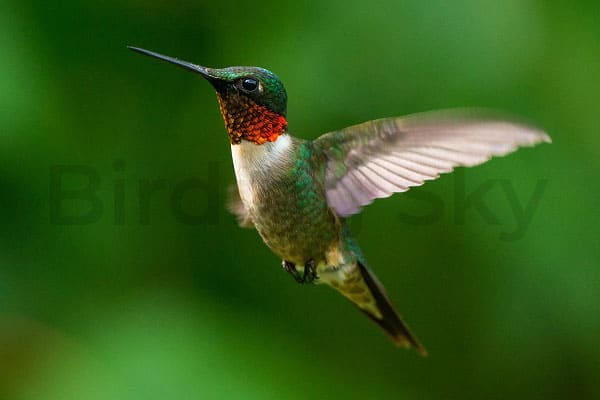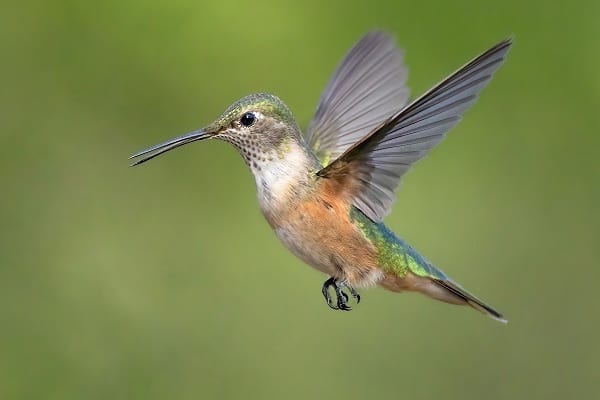When it comes to the natural wonders of Oklahoma, hummingbirds may not be the first thing that comes to mind. However, these tiny creatures, known for their vibrant colors and swift movements, are a thriving part of the state’s diverse wildlife.
In this article, we will delve into the enchanting world of hummingbirds in Oklahoma. From the well-known Ruby-throated Hummingbird to the elusive Calliope Hummingbird, each species has its unique traits that make them fascinating to observe.
Have you ever wondered how these delicate creatures survive in the Oklahoma climate? Or perhaps you are curious about the best ways to attract hummingbirds to your garden?
Prepare to be amazed as we uncover the mysteries of these remarkable birds and discover the beauty that lies within the hummingbird kingdom of Oklahoma.
Key Takeaways:
- There are five different types of hummingbirds found in Oklahoma: Ruby-throated Hummingbird, Rufous Hummingbird, Black-chinned Hummingbird, Broad-tailed Hummingbird, and the rare Calliope Hummingbird.
- Each species has its unique features, migratory patterns, and preferred habitats within the state.
- Conservation efforts are crucial for the well-being of hummingbirds in Oklahoma.
- Attracting hummingbirds to your garden in Oklahoma requires creating a hospitable environment with specific flowers, feeders, and habitat features.
- Observing hummingbirds can be a rewarding and educational experience, offering insights into the marvels of nature.
Types of Hummingbirds in Oklahoma (Names + Info)
1. Ruby-throated hummingbird
The Ruby-throated Hummingbird, one of the most common hummingbird species found in Oklahoma, captivates with its vibrant appearance and fascinating behaviors. With its stunning colors and remarkable migratory habits, this tiny bird offers a delightful sight to birdwatchers and nature enthusiasts alike.

One of the defining features of the Ruby-throated Hummingbird is its distinctive ruby-red throat feathers, which shimmer and sparkle in the sunlight, adding to its charm. This brilliant display is most pronounced in males, who use their vibrant throat colors to attract mates during the breeding season.
As migratory birds, Ruby-throated Hummingbirds undertake an incredible feat each year by crossing the Gulf of Mexico twice during their migration. They spend their winters in Central America or Mexico and return to Oklahoma during the spring and summer months to breed and raise their young.
During their migratory journeys, these hummingbirds often cover thousands of miles, relying on an impressive array of adaptations and a keen sense of navigation to find their way. Their ability to hover, fly backward, and even upside down, combined with their agility and high metabolic rate, ensures they can thrive in their preferred habitats, including woodlands, gardens, and meadows throughout Oklahoma.
If you want to attract Ruby-throated Hummingbirds to your garden, consider planting nectar-rich flowers such as trumpet vine, cardinal flower, bee balm, and salvia. These vibrant blooms will not only provide a reliable food source but also create a beautiful and inviting habitat for these enchanting creatures.
“The Ruby-throated Hummingbird is a true marvel of nature, with its dazzling colors and incredible migratory feats. Observing these tiny birds in action is a remarkable experience that reminds us of the wonders of the natural world.”
Ruby-throated Hummingbird Facts:
- The Ruby-throated Hummingbird is the only hummingbird species that regularly breeds in the eastern United States.
- They are the smallest bird species in Eastern North America, weighing only about 3-4 grams.
- Ruby-throated Hummingbirds beat their wings at an astonishing rate of 50 to 70 times per second.
- Despite their small size, they can fly at speeds of up to 30 miles per hour and even reach 60 miles per hour during courtship displays.
| Scientific Name: | Archilochus colubris |
|---|---|
| Size: | 3-4 inches long |
| Weight: | Approximately 3-4 grams |
| Habitat: | Woodlands, gardens, meadows |
| Migratory Season: | Spring and summer |
2. Rufous Hummingbird
The Rufous Hummingbird is a captivating species that can be found in Oklahoma. With its stunning coppery plumage, it is a sight to behold. This small bird is known for its vibrant orange feathers, which shimmer in the sunlight and create a beautiful contrast against its emerald-green back.
What sets the Rufous Hummingbird apart is its impressive long-distance migrations. Despite its small size, this remarkable bird travels thousands of miles each year, from its breeding grounds in Alaska and western Canada all the way down to Mexico and Central America. It holds the record as the longest migratory journey of any hummingbird species.

During its migration, the Rufous Hummingbird passes through Oklahoma, offering nature enthusiasts the rare opportunity to witness this extraordinary spectacle. The state serves as a crucial stopover point for these birds, providing much-needed rest and nourishment before they continue their arduous journey.
If you want to attract Rufous Hummingbirds to your garden in Oklahoma, consider planting native flowers such as Indian Paintbrush, Scarlet Beebalm, and Penstemon. These vibrant blooms provide a valuable food source for these nectar-loving birds.
Must Read about Hummingbirds in New York
Creating a welcoming habitat is also important. Provide a variety of perching options, such as branches or small twigs, for the hummingbirds to rest and observe their surroundings. Additionally, hanging a hummingbird feeder filled with a homemade nectar solution (1 part sugar to 4 parts water) can entice these delightful creatures to visit your yard.
Remember, it is crucial to avoid using pesticides or insecticides in your garden as they can harm hummingbirds and other beneficial insects. Embrace organic gardening practices to create a safe and sustainable environment for these beautiful birds.
Did You Know?
The Rufous Hummingbird has the highest metabolism of any warm-blooded animal, beating its wings up to 60 times per second, consuming half of its weight in nectar in a day.
Rufous Hummingbird Facts
| Scientific Name | Selasphorus rufus |
|---|---|
| Size | 3-4 inches in length |
| Weight | 0.1-0.3 ounces |
| Wingspan | Approximately 4-5 inches |
| Migratory Range | From Alaska and western Canada to Mexico and Central America |
| Habitat | Forests, woodlands, gardens, and meadows |
| Feeding Habits | Primarily nectar, occasionally eats small insects and spiders |
| Conservation Status | Least Concern (IUCN) |
3. Black-Chinned Hummingbird
When it comes to hummingbirds in Oklahoma, the Black-Chinned Hummingbird is a species that nature enthusiasts eagerly keep an eye out for. Known for its distinctive black chin feathers, this mesmerizing bird adds beauty and charm to the state.
The Black-Chinned Hummingbird can be found in various habitats within Oklahoma, including forested areas, desert shrubs, and even urban gardens. Its adaptability is one of the reasons why it thrives in the diverse landscapes of the state.

“The Black-Chinned Hummingbird is truly a captivating sight. Its shimmering green plumage and black chin feathers create a striking contrast that is simply mesmerizing.”
“Whether you’re exploring the rural areas of Oklahoma or simply enjoying the serenity of your own backyard, keep your eyes peeled for these delightful creatures.”
For those looking to attract Black-Chinned Hummingbirds to their gardens, consider planting a variety of flowering plants such as trumpet creeper, penstemon, and bee balm. These vibrant blooms will not only attract the Black-Chinned Hummingbird but also other hummingbird species that frequent the region.
To further create an inviting habitat, provide a hummingbird feeder with a sugar water solution. Hang the feeder in a shaded area to prevent the sugar water from spoiling too quickly. Sit back and enjoy the sight of these agile birds as they visit your garden.
| Black-Chinned Hummingbird Facts | |
|---|---|
| Scientific Name: | Archilochus alexandri |
| Size: | 3-4 inches (7.5-10 cm) long |
| Wingspan: | 4.3-4.7 inches (11-12 cm) |
| Habitat: | Forests, desert shrubs, and gardens |
| Range: | From northwestern United States to central Mexico |
| Diet: | Nectar, insects, and tree sap |
4. Broad-Tailed Hummingbird
The Broad-Tailed Hummingbird is a fascinating species known for its distinctive buzzing sound and stunning iridescent plumage. It is one of the hummingbirds that can be found in Oklahoma, adding to the state’s diverse avian population.
The male Broad-Tailed Hummingbird displays vibrant plumage, with a shimmering emerald-green back and a deep rose-colored throat. This throat patch is an important feature used during courtship displays as males engage in aerial acrobatics to attract mates.

During spring and summer, these hummingbirds can be observed in various habitats in Oklahoma, including forests, woodlands, and mountainous regions. They feed on nectar from a variety of flowers, enjoying the abundant floral resources that Oklahoma offers.
The Broad-Tailed Hummingbird is known for its remarkable long-distance migrations. It travels from its breeding grounds in the northern United States and Southern Canada to wintering grounds in Mexico and Central America. These hummingbirds make an impressive journey, covering thousands of miles each year.
If you’re lucky enough to spot a Broad-Tailed Hummingbird in Oklahoma, take a moment to appreciate its beauty and unique behaviors. Their presence adds a touch of vibrancy and wonder to the natural environment.
5. Calliope Hummingbird (Rare)
The Calliope Hummingbird (Stellula calliope) is a rare species that occasionally visits Oklahoma. Despite its rarity, encountering this exquisite bird is a delight for birdwatchers and nature enthusiasts alike.
The Calliope Hummingbird is named after the Greek muse Calliope and is known for its graceful flight and delicate beauty. It is the smallest bird species in North America and measures only about 3 inches long.

This rare hummingbird species has a unique appearance. Males have a vibrant magenta throat and a white collar, while females exhibit a greenish upper body and a pale throat. Their small size and distinctive markings make them easily distinguishable from other hummingbirds.
Although the Calliope Hummingbird is not a resident species in Oklahoma, it occasionally passes through the state during its migration. These birds breed primarily in western North America and spend the winter in Mexico and Central America. During migration, some individuals may make a stopover in Oklahoma before continuing their journey.
Factors such as climate change, habitat loss, and availability of food sources influence the presence of Calliope Hummingbirds in Oklahoma. As conservation efforts continue to protect their habitats along their migration route, the chances of encountering these rare hummingbirds may increase.
If you happen to spot a Calliope Hummingbird in Oklahoma, consider yourself lucky to witness this fleeting beauty. Take a moment to appreciate the wonders of nature and cherish the opportunity to observe one of the rarest hummingbird species.
Conservation and Tips for Attracting Hummingbirds in Oklahoma
When it comes to hummingbirds in Oklahoma, conservation efforts play a vital role in protecting these remarkable birds and sustaining their populations. By creating a welcoming environment in your garden, you can attract these enchanting creatures and support their well-being. Here are some tips to help you create a hummingbird-friendly habitat.
Firstly, consider planting native flowers that provide nectar-rich food sources. Hummingbirds are attracted to vibrant blooms such as cardinal flowers, scarlet beebalm, and trumpet vines. These native plants not only offer a reliable food source but also blend harmoniously with Oklahoma’s natural landscape.
Additionally, installing hummingbird feeders can supplement the natural nectar supply, especially during times of scarcity. It’s important to use a solution of four parts water to one part table sugar, without any food coloring or artificial sweeteners. Regularly clean and refill the feeders to ensure the hummingbirds’ health and well-being.
Creating suitable habitat features can also help attract hummingbirds. Provide perches like small branches or trellises for the birds to rest and observe their surroundings. Consider adding a shallow water source, such as a birdbath, for them to drink and bathe in. These habitat enhancements make your garden more inviting for these delightful creatures.
